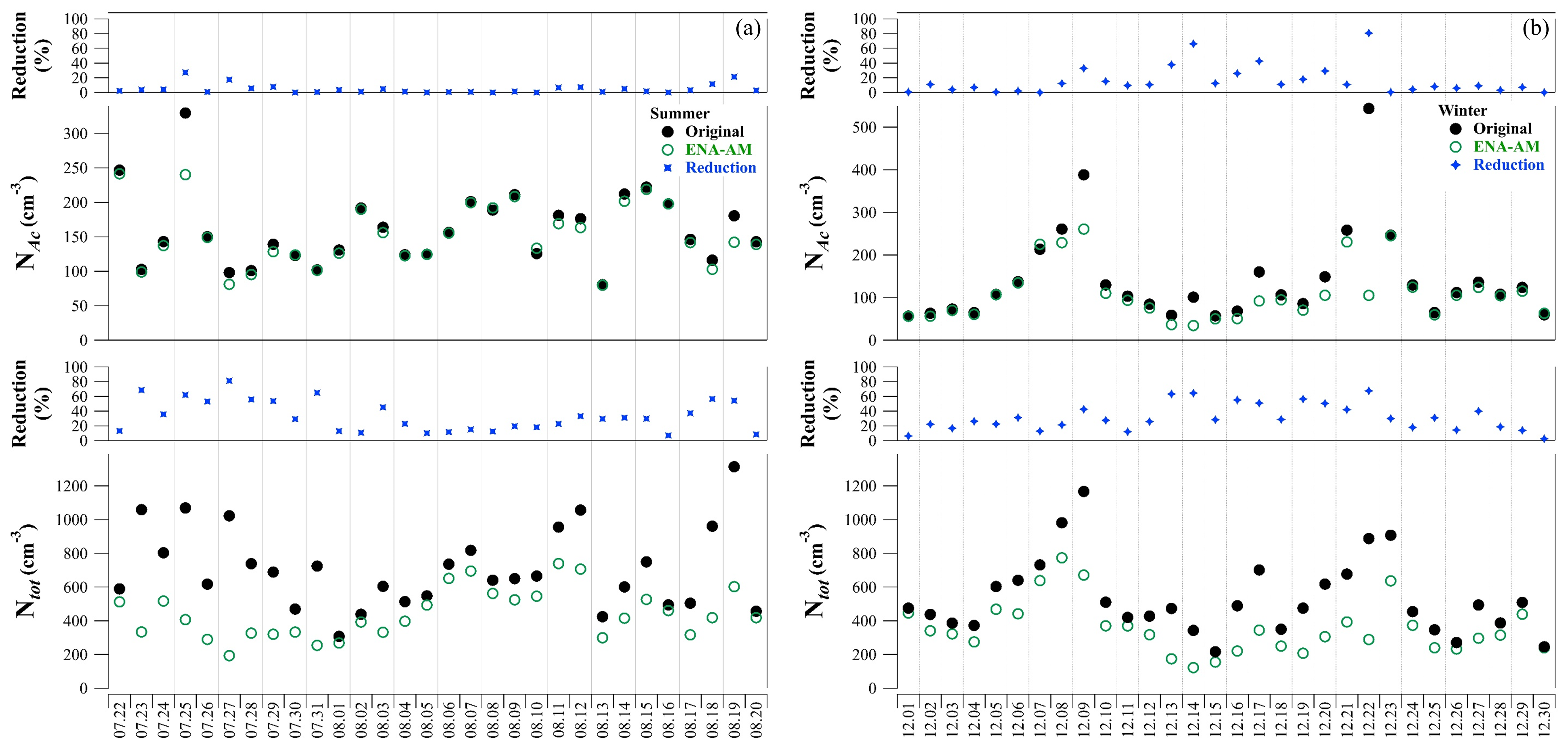Extracting regionally representative submicron aerosol data
Submitter
Aiken, Allison C
— Los Alamos National Laboratory
Area of Research
Aerosol Properties
Journal Reference
Gallo F, J Uin, S Springston, J Wang, G Zheng, C Kuang, R Wood, E Azevedo, A McComiskey, F Mei, A Theisen, J Kyrouac, and A Aiken. 2020. "Identifying a regional aerosol baseline in the eastern North Atlantic using collocated measurements and a mathematical algorithm to mask high-submicron-number-concentration aerosol events." 20(12), 10.5194/acp-20-7553-2020.
Science

Figure 1. Daily average (a) summer and (b) winter total submicron (Ntot; < 1 micron diameter) and Accumulation-mode (NAc; 100 – 300 nm diameter) aerosol number concentrations in 2017. Original aerosol observing system (AOS) data in black and the new data product with local aerosol events removed (ENA-AM; ENA-Aerosol Mask) in green with percent reductions in blue. From journal.
Local sources of small particles, known as aerosols, can complicate studying their role on regional to global scales within the Earth system. In 2017 during the Aerosol and Cloud Experiments in the Eastern North Atlantic (ACE-ENA) Intensive Operational Period, a research team of U.S. Department of Energy (DOE) scientists deployed a temporary aerosol site within 1 km of the DOE Atmospheric Radiation Measurement (ARM) Eastern North Atlantic observatory to identify these sources. Regionally representative aerosol periods were identified by validating aerosol observing system (AOS) data with the temporary aerosol site and the ARM Aerial Facility (AAF) G-1 aircraft after removing local sources.
Impact
The smallest particles sizes (diameters < 100 nm) measured by the AOS at the ENA observatory were the most impacted by local aerosol sources. When studying regional aerosol processes and their impacts on the Earth system, it is important to identify time periods with high-particle-concentration events that can last from minutes to hours depending on the source and proximity to the site. New data products were developed and can be found online via the ARM Data Discovery tool to enable regional aerosol process studies using AOS data with reduced bias and uncertainties from local high-concentration aerosols.
Summary
Small particles in the atmosphere known as ambient aerosols play a large and uncertain role in cloud formation and precipitation, as well as directly affecting solar radiation. These particles are ubiquitous in the Earth’s atmosphere and have many sources: some are small and local while others are large and regional in origin. ARM's AOS collects numerous aerosol properties at time resolutions on the order of minutes and even seconds. High-time-resolution data is important to improve our understanding of the role of these particles within the Earth system since aerosols are dynamic, undergoing chemical and physical changes on the order of minutes to hours.
When studying regional aerosols, there are often short periods impacted by local sources that do not represent larger regional processes. Most events at ENA were dominated by Aitken-mode particles while the larger sizes, such as the Accumulation mode, were less affected. After removing the local aerosol event periods, monthly submicron aerosol mean number concentrations were reduced by factors of 1.65 in the summer and 1.55 in the winter. These techniques can be applied at other AOS and aerosol sampling locations to improve data quality for aerosol process studies.
Keep up with the Atmospheric Observer
Updates on ARM news, events, and opportunities delivered to your inbox
ARM User Profile
ARM welcomes users from all institutions and nations. A free ARM user account is needed to access ARM data.


















